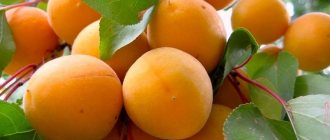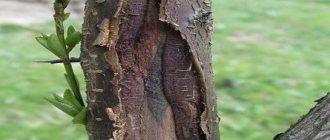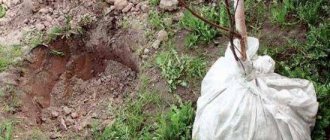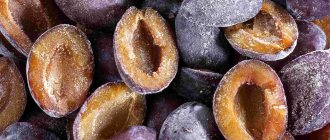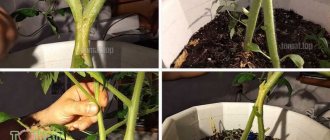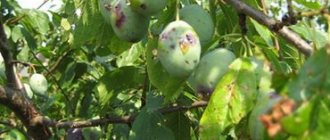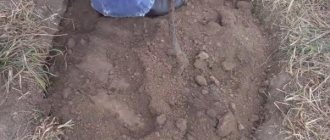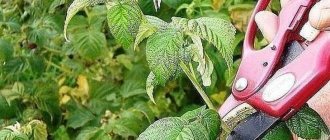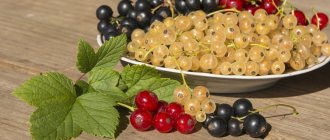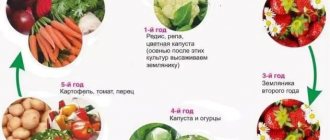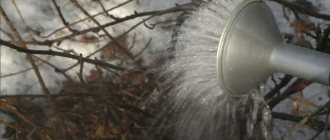05/07/2020 391 Tree-like
Author: Anatoly
Grafting is a method of propagating a fruit tree, which occurs through the artificial connection of plant parts. The taste, size and yield of the fruit will depend on what can be grafted onto a plum tree. Usually, stone fruit trees are chosen as a scion for this crop.
[Hide]
What is tree grafting and why is it needed?
Tree grafting is a way to obtain an improved version of a fruit crop endowed with the positive qualities of the grafted plant.
The grafting material consists of the following parts of the plant that are attached to the tree:
- stem;
- root;
- leaf;
- flower;
- bud;
- fetus.
When a plant part is planted onto a fruit tree, the grafting will be called a scion. And the fruit crop on which manipulation is carried out is called a rootstock. Most often, the scion and rootstock are fused to each other exactly along the cambium layer, that is, along the annual rings of wood formed during the growth process.
Trees are grafted for the purpose of:
- bring the fruiting period closer;
- increase the amount of harvest;
- make the tree capable of bearing fruit;
- improve the taste characteristics of fruits;
- improve the fruit tree;
- strengthen the health and increase the immunity of the plant in the cultivated strip.
Grafting fruit trees - how to prepare cuttings
Cuttings for summer grafting of trees are cut shortly before this “operation”. But for winter and spring grafting, harvesting is carried out in the fall, and the cuttings themselves are stored in a cool place.
Harvesting plum cuttings is an extremely important undertaking; it is important to take into account many nuances.
- The appropriate time for harvesting is the end of autumn, before severe frosts set in. But if you did not have time to cut plum cuttings on time, this can be done in early spring, provided that the winter was not very severe.
- Take cuttings from annual growths (the end of the branch to the first branch), which are at least 40 cm long. Choose cuttings on the south side of the crown. Take only well-ripened, lignified shoots. Pay attention to the vegetative buds: they should be well developed.
- Having selected a shoot of the required variety on a tree, before cutting, first wipe it with a clean cloth and cut the required number of cuttings about 30 cm long.
- If you prepare cuttings immediately before grafting, be especially careful: do not touch the cuts so as not to infect the scion, because this may negatively affect their survival rate.
- If you are preparing cuttings of several varieties, it is important not to confuse them with each other during storage. To do this, tie the cuttings of each variety into bunches and attach labels with the names to them.
Before grafting, cuttings should be kept in a cool place where there are no temperature fluctuations. Otherwise, from the onset of heat, cuttings of stone fruit crops may “wake up” at the end of winter - and this is not the right time for grafting.
The best place to store cuttings in winter is a snowdrift.
However, the weather has been so unpredictable in recent years that in winter snow and frost are often replaced by thaw and rain. If you live in a similar climate zone, then it is better to store the cut cuttings in the refrigerator or basement, where the temperature always remains close to 0 ° C. In such conditions, they will remain dormant until spring, until the time favorable for grafting arrives.
When to graft a plum tree?
You can graft a tree:
- in spring;
- in summer;
- in the fall.
The best time for grafting plum crops is the first spring months - March and April. During this period, the internal juices of the tree are activated, and the process of swelling of the buds begins. The growth of the graft under such conditions proceeds faster and is safer for the plant. The summer procedure is usually a re-vegetation. If the spring grafting of the plum was unsuccessful, then in June-July you can do it again.
Autumn grafting runs the risk of falling under the first frost and not taking root. Therefore, it is not recommended to graft plum trees in September and October.
When is it better to plant plums - in spring or autumn?
Many agronomists and gardeners agree that it is better to plant fruit trees, including plums, in the fall, because... During this period, the young seedling will intensively grow the underground part, i.e. its root system (which is necessary in the first place), and not aboveground, in other words, it definitely will not vegetate.
Alternative opinion
To be fair, it should be said that some gardeners, on the contrary, adhere to the old rule: it is better to plant pome crops (apple trees and pears) in the fall, and stone fruit crops (plums, cherries, cherries, apricots) in the spring. The fact is that stone fruit crops (including plums) are considered less winter-hardy, so it is recommended to plant them in the spring so that they have time to take root well and become stronger before winter.
Video: at what time is it better to plant seedlings of fruit and berry crops
Planting plums in spring and autumn: optimal timing
Well, we have examined several points of view on when it is better to plant plums - in spring or autumn. The decision is yours!
Next, it’s time to familiarize yourself with the specific recommended dates for planting plums in spring and autumn in different regions.
Spring planting
So, you need to have time to plant a plum in the spring even before the buds bloom on the seedling, in other words, before it enters the growing season (i.e., the plant must still sleep).
At the same time, an important condition for successful spring planting is positive air temperature, not only during the day (it should already be +5), but also at night.
Thus, it is highly advisable to have time to plant while the seedlings are still “in the dormant stage”, otherwise this will certainly negatively affect their survival rate and disrupt their natural development cycle.
As for the approximate timing, depending on the climatic characteristics of the region, spring planting of plums is recommended from late March-April to early-mid May:
- Thus, in the south of Russia, plum seedlings can be planted in open ground in the second half of March-early April.
- In the Middle Zone (Moscow region), plums are planted no earlier than the second half of April.
- In Siberia and the Urals, spring planting of plums is carried out in late April-early May.
Autumn planting
The main rule when determining the optimal timing for autumn planting is to calculate when stable frosts will arrive and plant 3-4 weeks before them, i.e. you should have about a month left. The fact is that the seedlings must have time to take root well before the onset of cold weather and successfully prepare for winter, and this will take time.
Thus, depending on the climatic characteristics of the region, autumn plum planting is recommended from September to the end of October:
- So, in the south of Russia, plums can be planted until late autumn - until the second half of October.
- Gardeners in the Middle Zone (Moscow region) should have time to plant plums in the fall before the end of September (maximum in early October).
- In colder regions - in the North-West (in the Leningrad region), as well as in Siberia and the Urals, plums are planted in early autumn - in the first half of September.
Video: planting plums in autumn in October from a container
According to the lunar calendar in 2021
The lunar calendar can help you choose the optimal date for planting seedlings.
Thus, favorable days for planting plums in spring and autumn in 2020 according to the lunar calendar are:
- in March - 26-29;
- in April - 11-15, 24, 25;
- in May - 2-10;
- in September - 19-26;
- in October - 3-13, 18-21.
Of course, it is not always possible to get to the dacha on favorable days, so the main thing is not to land on unfavorable dates according to the lunar calendar - New Moon and Full Moon days, as well as the period when the Moon is in Aquarius, because it is a barren and dry sign - in italics.
According to the lunar calendar for 2021, the unfavorable days for planting plum seedlings are the following dates:
- in March - 9, 19-21, 24;
- in April - 8, 15-17, 23;
- in May - 7, 13-14, 22;
- in June - 5, 9-11, 21;
- in July - 5, 7-8, 20;
- in August - 3, 4-5, 19, 31;
- in September - 1, 2, 17, 27-28;
- in October - 2, 16, 24-26, 31;
- in November - 15, 20-22, 30.
Vaccination methods
There are several ways to graft a plum tree:
- copulation;
- budding;
- into the cleft;
- for the bark;
- into the side cut;
- bridge;
- ablation.
Copulation
Process in Latin means connection. The scion and rootstock are adjusted to each other in such a way that the bases of the cuttings fit snugly against each other.
Copying happens:
- simple;
- improved.
Scheme of simple and improved plum copulation
Benefits of copying:
- the scion takes root well;
- You can connect thin cuttings from 3 to 15 mm.
Disadvantages of copying:
- high risk of scion joint displacement;
- when voids appear between the cuttings, mold appears;
- it is necessary to connect the cambial layers between the scion and the rootstock;
- it requires skill, attentiveness and a good eye.
The video from ulybays shows simple and improved copulation of trees.
Simple
Copying in a simple way occurs in the following sequence:
- The rootstock and scion are trimmed at an angle of 45° and with a diameter of 4 cm.
- Attach the cuttings to each other as tightly as possible.
- Wrap the grafting site tightly and cover it with garden varnish (putty for speedy healing of wounds and cuts of fruit trees).
Improved
Copulation in an improved way consists of creating equal notches on the scion and rootstock and occurs according to the following technology:
- Cut equal splits on the cuttings.
- Connect the splits to create a single whole.
- Wrap the grafting site and cover it with varnish.
Budding
To graft a plum by budding means to implant a bud into a tree branch.
Benefits of budding:
- There is no mandatory deadline for vaccination (spring-summer);
- grafting is easy to perform even for an inexperienced gardener;
- There is no need to connect the cambial layers between the scion and rootstock.
The disadvantage of budding is that the grafting is not suitable for mature trees.
The video shows the process of budding a plum to a cherry plum. Photographed by Nikolay Pomilyaiko.
Algorithm of actions
Budding consists of the following stages of work:
- On a branch of a donor tree, a bud is carefully cut off along with the wood around it.
- Select a healthy branch from the plum tree and cut 3–4 cm of bark using a knife.
- The kidney is applied to the incision and tightly wrapped with electrical tape.
Plum budding scheme
Into the cleft
To graft a plum tree into a split is to plant donor cuttings into a split tree trunk.
Advantages of grafting using the split method:
- the scion cuttings are securely fixed in the gap;
- high degree of graft survival;
- You can use a scion of any diameter.
Disadvantages of grafting using the split method:
- Fruit crops can be grafted only in spring (March-early April);
- the method is not suitable for young and thin trees;
- it is necessary to connect the cambial layers between the scion and the rootstock.
Grafting a plum into a cleft was demonstrated by the SAOS + channel about everything in the world.
Algorithm of actions
Sequence of grafting into cleft:
- Select a tree limb and saw off about 50 cm from the base.
- Split it in the middle with an ax 3-4 cm deep.
- Cuttings for scion from 3 to 10 cm long should be sharpened with an ax or knife.
- Drive the scion into the split using a hammer and wrap it tightly with electrical tape.
- Coat the area of the split with garden varnish and cover it with protective polyethylene.
Cleft grafting scheme
For the bark
Grafting behind the bark means deepening the cutting of the donor fruit tree behind the bark of the rootstock.
Advantages of grafting using the bark method:
- there is no need to connect the cambial layers between the scion and the rootstock;
- the grafting is obtained for the growth of the fruit tree;
- You can grow several scions into one branch.
Disadvantages of grafting using the bark method:
- unreliable coupling;
- there is a risk of the scion not taking root.
Grafting with a cutting behind the bark was demonstrated by Alyona Priest.
Algorithm of actions
The sequence of grafting a tree using the bark method:
- Cut down a plum branch for a rootstock.
- Cut the bark 4–5 cm and turn it out.
- Sharpen the end of the rootstock with a knife at 45° and carefully drive it behind the bark.
- Secure the graft with electrical tape.
Bark grafting scheme
Into the side cut
Grafting of plums into a side cut is carried out to form the crown of a fruit tree.
Advantages of lateral incision grafting:
- the manipulation is not tied to one season (spring-summer);
- There is no need to connect the cambial layers between the scion and rootstock.
Disadvantages of lateral incision grafting:
- not suitable for thin young branches of a fruit tree;
- You cannot use a scion of any diameter.
Lateral incision grafting is presented by Oleg Zanedinov.
Algorithm of actions
The sequence of grafting a plum into a side cut:
- Choose a healthy, strong plum branch.
- Having retreated 20 cm from the base of the branch, make a cut with a knife deep into the woody part.
- Insert the scion into the resulting opening and tighten with twine.
Lateral incision grafting
By the bridge
Bridge grafting of a plum tree is the main way to save a fruit tree from the effects of rodents.
Removing buds from the scion is a feature of bridge grafting. The manipulation is carried out to set the direction of growth of the cutting.
Benefits of bridge grafting:
- there is no need to connect the cambial layers between the scion and the rootstock;
- Grafting can revive both young and old trees.
Disadvantages of bridge grafting:
- difficult to perform;
- tied to the time of the event (after the start of the growing season);
- You cannot use a scion of any diameter.
Bridge grafting was demonstrated by user Mikhail Chertok.
Algorithm of actions
The sequence of grafting a plum with a bridge:
- Clean the damaged area of the trunk from any remaining bark and dirt.
- Prepare a scion one and a half times longer than the affected area.
- Sharpen the ends of the scion with a knife and remove the buds from them.
- Make cuts at the top and bottom on the rootstock just above the wound.
- Squeeze the scion branches one by one and secure with a tourniquet and electrical tape.
- Cover the wound with varnish and wrap it in polyethylene.
Bridge grafting scheme
Ablactation
The ablactation grafting method involves merging a scion and a rootstock.
Advantages of ablation:
- it is possible to revive even a severely damaged tree;
- vaccination is easy to perform;
- the vaccination is not tied to a specific time of year (spring-autumn).
The disadvantage of ablation is that the cambial layers between the scion and the rootstock need to be connected.
The ablation process is presented in the video by user Vladislav Kompaniets.
Algorithm of actions
Ablation sequence:
- Select approximately identical branches or trunks of the scion and rootstock.
- Cut off notches with a diameter of 5–6 cm on them.
- Place the notches close to each other, trying to connect the cambial layers of the branches.
- Tie tightly with a tourniquet and cover with garden varnish.
- Wrap the grafting site with rags and polyethylene.
- After 4–6 months, untie the grafting site and trim off the grown donor shoots.
Ablation grafting scheme
- bringing plants closer together;
- fixing plants;
- fused plants;
- separation of the scion from the mother plant.
Rootstock selection
It is better to use related trees, but many gardeners choose pome trees, apple or pear trees as mother trees, which is wrong. When crossing intraspecific fruits, they become more juicy, while interspecific fruits acquire new qualities.
You can graft a plum onto a plum, wild, semi-cultivated or varietal plant if it has become overgrown or the yield has decreased. When using cuttings of several varieties, a bouquet of flavor shades is obtained. The peculiarity of such germination is that the hybrid inherits the best qualities of its parents. It turns out interesting if multi-colored varieties are crossed, for example, blue with yellow or yellow with red.
- Wildflowers increase immunity and frost resistance when grown in cool climates. Beginner gardeners are recommended to use this option.
- To increase stress resistance, varietal cuttings are grown onto sloe. The shrub is unpretentious, bears fruit in the southern regions and the central zone, and quickly forms callus.
- You can also graft onto cherry plum, only in this case it is recommended to select a low rootstock. The survival rate is good, but the peculiarity of hybrids is that they quickly grow. Gardeners recommend using the “split” method in this case.
- When grafting a plum onto a cherry, you need to decide on the variety of the mother plant. Best combined with a felt look. Its features are decorativeness, short stature, sweet and sour berries covered with delicate fluff, which is why the second name is textile. The tree is frost-resistant, has high yields, and is easily propagated by cuttings. If you graft a plum onto a felt cherry, there is no doubt that the scion will take root.
Delicious hybrid varieties are obtained if you use apricots or peaches as the mother plant (preferably wild or semi-cultivated ones). True, such experiments can only be carried out in the southern regions. Any cold snap is detrimental, and resistance to temperature changes and fungal diseases decreases.
Attention! If you want to try something new, you can graft a peach onto a plum, but it’s still better to do the opposite.
You should not experiment with grafting a plum onto an apple, pear or bird cherry tree. The cuttings will take root, but the tree will be sick for a long time and the taste will decrease. The hybrid will not acquire resistance to temperature changes of the mother plant. You can graft an apple tree with pear and quince, or vice versa.
Interesting! I would like to try something new and unusual - before growing a plum cutting onto a cherry tree, plant a peach cutting.
Beginner gardeners often make mistakes that prevent them from achieving good results. They use blunt instruments, do not disinfect them, work slowly and the cut area has time to dry out and oxidize. The cambial layers are not aligned and the wrong rootstocks or “donors” are chosen for the cuttings.
For everything to be successful, you need to change the approach to the procedure. This is not a surgical operation, but during it you should also follow the rules of asepsis. Use clean tools, do not touch the cut with your hands, and do not forget to treat the cut area with garden varnish. Even electrical tape and film, for fixation, need to be wound not from top to bottom, but from bottom to top.
To gain experience, you need to start by grafting plum onto cherry plum, wild cherry or felt cherry. In these cases, the survival rate is the highest, even if you make a mistake.
General rules and tips for plum grafting
Before carrying out plum grafting activities, you should familiarize yourself with the basic rules and recommendations:
- When grafting a fruit tree, you need to use a special tool - a grafting pruner;
- It is best to cover the grafting site with a self-destructive tape that allows air to pass through and does not pinch the branches;
- all manipulations must be sterile, and at the end of the work, the incision sites must be covered with garden pitch;
- It is better to grow the scion near the tree trunk - part of the trunk from the root to the first branch;
- in pursuit of an even cambial layer of the cutting, it is important not to overdo it, so as not to reduce the scion to a critical size that does not take root well;
- the cambium layers must match;
- The scion is grown only on fresh cuts of the rootstock;
- the grafting should not be done on the south side of the tree - to avoid direct sunlight;
- The best time for vaccination is a clear early morning with air humidity of 60%.
What can be grafted onto a plum tree?
You can graft onto a plum tree:
- cherry;
- apricot;
- cherry plum;
- peach.
The listed trees are stone fruit crops; they can give plums not only a varied range of flavors, but also resistance to climatic conditions:
- Apricot and peach take root well on plums when grown in acidic soil. The location of the rootstock is chosen above 30 cm from the base of the tree; usually these are strong skeletal branches of the fruit crop.
- Grafting cherry plum will prevent pest control. This culture is resistant to diseases and temperature changes.
- Grafting a cherry onto a plum will provide the fruit crop with drought and frost resistance. It is recommended to use the Bessey sand cherry variety. They try to grow it to the root of the plum tree.
It is worth remembering that southern varieties of fruit trees will have difficulty taking root in the middle zone. At the first thaw, the southern crop begins to actively breathe with its roots, which leads to the root collar becoming warm and the tree dying due to unexpected frosts. Therefore, it is better to choose cuttings from neighboring regions as a scion.
A plum tree can be grafted onto a different variety of olive tree. This common manipulation allows the crop to bear fruit and improves the quality of the harvest.
The best varieties of scions are:
- VVA-1 - a hybrid of cherry and cherry plum;
- OP-23-23 - semi-dwarf hybrid for plum, cherry plum, cherry and peach;
- Druzhba is a short rootstock for cherry plum and apricot;
- Eureka-99 is a rootstock with medium growth for plum, peach and cherry;
- AP-1 - rootstock with strong growth for grafting plum, peach and apricot;
- VSV is a semi-dwarf low-growing rootstock for plum, cherry plum and peach.
Which tree can a plum be grafted onto?
There is an opinion among gardeners that stone fruit trees can be grafted onto stone fruit trees, and pome trees can be grafted onto pome trees. The following fruit crops belong to stone fruits:
- Apricot.
- Cherry plum.
- Felt cherry.
- Common cherry.
- Steppe cherry.
- Dogwood.
- Homemade plum.
- Chinese plum.
- Turn.
- Damsons.
- Peach.
- Cherries.
Theoretically, you can graft plum onto any tree from this list. However, in practice everything is not so simple.
Grafting plum onto plum
Intraspecific vaccination has the best chance of being successful. Plum is grafted onto plum to improve fruiting performance, preserve the species or propagate it. Many people graft several varieties onto one plum tree.
Grafting plum onto sloe
The sloe is the plum's closest relative. Wild blackthorn is an extremely unpretentious plant and an indispensable rootstock for gardeners who want to increase the frost resistance of their plum trees. Plum cuttings grafted onto sloe trees take root very well.
At the same time, resistance to frost increases so much that even in the most severe frost they remain undamaged, while other varieties of plums freeze completely.
Is it possible to graft a plum onto a wild plant?
You can also use dichka (wild plum) as a rootstock for plums. As a rule, grafting of this kind is successful, and the result is increased tree resistance to adverse weather conditions, temperature fluctuations and precipitation. Experienced gardeners recommend that beginning gardeners use wild plum rootstock. It allows you to get good practice and does not require perfect accuracy when grafting.
Is it possible to graft a plum onto a bird cherry?
You can graft a plum onto a bird cherry tree. In most cases, the scion will take root and even produce leaves. However, bird cherry will not provide the rootstock with proper nutrition, so the leaves on the scion will turn yellow ahead of time, wither and fly off. There will be no full growth of a plum on a bird cherry rootstock.
Grafting plum onto cherry
Such grafting is possible if you take not an ordinary, but a felt cherry as a rootstock. The work must be done quickly and accurately, since cherry cuts oxidize very quickly and the survival rate drops sharply. The result will be a plum tree that will be approximately two times lower and more compact than usual, and it will begin to bear fruit a year or two earlier.
The tree will also be more resistant to weather conditions and will grow better in heavy soil.
Grafting plum onto apricot
It is difficult to graft a plum onto an apricot rootstock, but it is possible. The main problem is that not all varieties of plums get along with it. But if the grafting is successful, plum fruits on apricot rootstock will be more tasty and aromatic than ordinary ones.
Grafting a blue plum onto a yellow one
Since both the rootstock and the scion are plums, the grafting will certainly be successful if all measures are done correctly. If the grafting is done not on a seedling, but in the crown of an adult tree, the gardener will have a very interesting plum, with blue fruits on one side and yellow ones on the other.
Features of choosing a scion and rootstock
Vaccination is comparable to surgery. Therefore, before such manipulation, cuttings and fruit trees are carefully examined and studied for the absence of diseases and pests.
If the scion and rootstock are healthy, then use the following recommendations:
- the scion should be dormant and green;
- the cutting for grafting should bend easily, which indicates its high viability;
- recommended scion length from 30 to 40 cm;
- the optimal cutting diameter for grafting varies from 0.7 to 10 cm;
- in the evening before grafting, the scion cut is renewed and the cutting is dipped into a preparation with a growth accelerator;
- for grafting, the rootstock must awaken and activate sap flow in the bark;
- You can check the readiness of the rootstock by lightly cutting the bark and looking at the cambium layer, which should be green.
Preparing for vaccination
Immediately before grafting, it is necessary to prepare the rootstock and scion.
| Rootstock | Scion |
| Wipe the branch that you plan to graft with a clean damp cloth to clear it of dirt, cobwebs, moss, etc. On the day of grafting, cut it to the required length and trim the cut with a sharp knife | Place the shoots prepared in the fall into a warm room a day before grafting. On the day of grafting, cut them into cuttings 10-15 cm long, without touching the cut surface with your hands. Choose the middle part of the shoot, because It has been noticed that scions from the middle part of cuttings harvested in the fall take root best. It is important that each scion has 2-3 healthy buds |
Tree care after grafting
In order for the cutting to take root and the grafting to be successful, after the manipulation it is necessary to continue caring for the tree.
Caring for a fruit tree after grafting includes:
- the place of cuts is covered and insulated with film;
- voids and stumps are covered with varnish or tree paint;
- in the middle of summer, a constriction in the form of a ribbon or twine is untied from the tree;
- on an established branch, remove excess inflorescences, leaving 2–3 experimental flowers;
- in the spring, grafted trees are fed with nitrogenous fertilizers that stimulate growth;
- Before autumn hibernation, the grafted crop is watered with phosphorus and potassium preparations to increase the winter hardiness of the tree.
The graft that has taken root will make itself known by producing leaves and flowers.
Adviсe
In order for the cutting to take root with the greatest probability, have time to pinch the plum: connect and secure the “bare” parts of the tree before oxidation processes begin in them. When oxidation begins, every minute there is less chance of a successful outcome of the procedure.
Use only disinfected and very sharp tools. If you don’t have a special antiseptic liquid on hand, you can also wipe the knife with regular alcohol. After disinfection, the cutting tool should be wiped dry.
